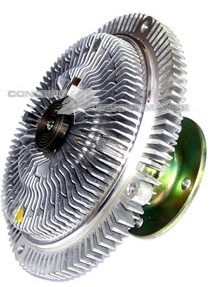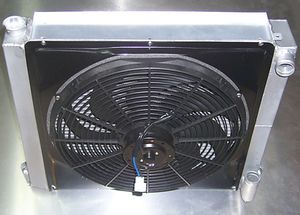Fan Clutch
The Fan Clutch is a thermostatic clutch mounted to the water pump. It transfers variable rotational force to the cooling fan.
Contents
Operation
As the fan/clutch assembly rotates, it draws air through the radiator and across the fins of the fan clutch. This is to improve airflow across the radiator during idle or slow driving conditions. As the engine coolant heats up, the air moving through the radiator becomes hotter. This hot air then moves through the fins of the fan clutch, and causes a viscous liquid inside to thicken, tightening the rotational force provided to the fan. This causes the fan to spin faster, which draws more air through the radiator, cooling it. This system has the effect of maintaining a good flow of air across the radiator, allowing the thermostat to maintain a safe operating temperature.
The fan & clutch is primarily utilized at low or idle speeds, as this is when airflow through the radiator is weakest. As the vehicle speeds up, air naturally passes through the radiator, reducing the temperature of the fan clutch. The fan clutch then "relaxes" and lets the fan free-spin slightly, which reduces parasitic draw on the engine.
Versions
There are two versions of the fan clutch for the Z32.
- NA (red dot)
- TT (yellow dot)
They are visually identical, other than the dot on their face. The TT version engages at a lower temperature to increase airflow.
Failure & Replacement
Fan clutches traditionally fail in a typical fashion. The clutch begins to tighten more frequently at lower temperatures, causing it to constantly engage and drive the fan, even when it's not necessary. It eventually reaches a point where it's practically locked "on" all the time. This can also cause excess wear on the water pump bearings, and often causes the drive belt to slip due to the extra drag.
Over time, the fan clutch fails to engage and, instead of "locking up," begins to free spin. The rotating shaft begins to fail, and, aside from being ineffective in cooling, the clutch becomes very wobbly (increasing wear on the water pump), before failing completely (and often catastrophically).
Fan clutches should be replaced with Nissan OEM parts. These can be quite expensive, but used good clutches can often be found relatively inexpensively. Aftermarket, non-Nissan clutches tend to have poor thermostatic variation, leaving them either always on or always off.
Electric Fans
Because the fan clutch is directly driven by the engine, it generates a small draw on the engine due to drag created by the fan blades. This, coupled with the high cost of OEM replacements, leads many users to replace the clutch-operated fan assembly with an electric fan, as found on many newer cars.
There are a few popular efan setups commonly used on the Z32.
- The 1989-1994 Nissan Maxima e-fan (which is a bolt-on installation on the NA Z32 radiator).
- The 1992-1995 3.5L Ford Taurus/Mercury Sable two-speed cooling fan, which moves between 2800 CFM and 4500 CFM.
- Various aftermarket performance cooling fans (SPAL, Mishimoto, Autozone/ebay parts, etc).
Generally, the Maxima fan is considered an acceptable replacement/upgrade for the NA Z32, but some feel it's not enough for the TT--not to mention it won't bolt right in as it will on the NA.
The clutch fan assembly is said to move as much as 5000 CFMs at high temp and RPM, but of course with more airflow comes greater drag. There is no doubt that the clutch fan assembly moves more air than any other setup, but to some the pros of an efan setup may outweigh the cons.
Advantages to an e-fan
- Less "roaring semi truck" noise.
- Less parasitic draw on the engine.
- Usually around the same price or cheaper than replacing the clutch with a new OEM unit.
- Can operate at consistent speeds regardless of engine speed.
Disadvantages of an efan
- Cost for a high-quality efan can be high.
- More difficult to install, often requiring some fabrication for mounting and basic electrical wiring skills.
- Often doesn't move as much air as a stock clutch setup.
Shrouds and Installation
The most important (and overlooked) thing to remember when purchasing an efan setup is to find one with a well-designed fan shroud. When the car is at motion, air naturally passes through the radiator. The fan setup (electric or clutch-type) is only utilized at low speeds and idle. In order for the fan to effectively pull air through the radiator, a good shroud is very important.
SPAL and Mishimoto setups both include shrouds, though the Mishimoto setup is known to move ~1900 CFM, which most would consider inadequate for the Z. The SPAL kit moves around 2500 CFM, but has a very well-designed shroud making it one of the more effective setups.
Finally, the electrical configuration behind the fan is important and varies between manufacturers. A high-quality efan setup will use a thermostatic switch to control the fan, with user-configurable on/off speeds. Some even feature multiple speeds to conserve draw on the electrical system when "full blast" isn't necessary. All efan setups should come with adequate installation instructions, including electrical.

